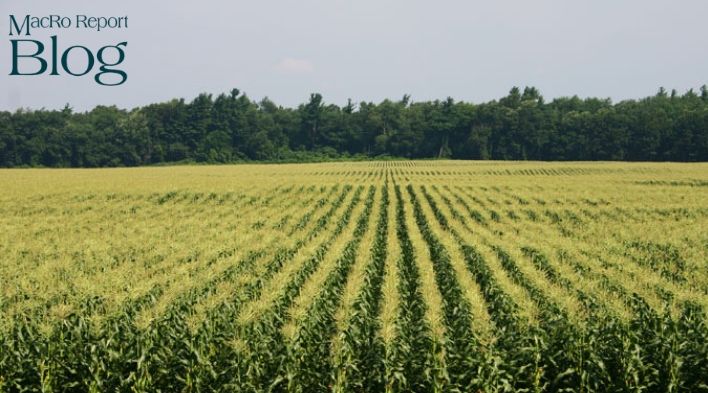In selling or buying a tract of agricultural real estate, why does the sometimes hefty have to be paid, and how it can be avoided?
 The March 20, 2019 MacRo Blog focused on the agricultural use assessment in Maryland. This special tax assessment category provides financial benefits to landowners that keep their land in agricultural use, which in certain cases may include woodland.
The March 20, 2019 MacRo Blog focused on the agricultural use assessment in Maryland. This special tax assessment category provides financial benefits to landowners that keep their land in agricultural use, which in certain cases may include woodland.
As seems to be true with all things in life, the benefits of any particular course of action come with costs that also need to be considered. As briefly described in the March blog, in the case of the Agricultural Use Assessment there is the potential that a substantial Agricultural Transfer Tax (“ATT”) will be imposed if the land is converted from agricultural use to another use.
The ATT works along with the agricultural use assessment and agricultural preservation programs to encourage the preservation of farmland and woodland in Maryland. The ATT is double edged sword – it acts as a deterrent to the conversion of agricultural land to more intensive uses and funds generated from the ATT are used to support land preservation programs at the both the state and local level.
This intent of this short article is to provide some basics of the ATT as it applies to current landowners and prospective land buyers. The statutory framework for the ATT is provided in Maryland’s Tax-Property Article which, like all laws, is complex and full of “if’s”, “ands” and “buts”. Every property subject to the ATT will have its own unique situation and both land sellers and buyers are advised to consult with an attorney, accountant and real estate professional experienced with the agricultural transfer tax prior to entering into any binding agreement for the sale or purchase of land.
All land that benefits from the agricultural use assessment is subject to the ATT when sold unless either: 1) the buyer signs a declaration of intent to keep the entire property in agricultural use for five year; or 2) the sale meets some very specific exemptions (for example sale to a government or public agency). When an ATT is due the amount of the tax is computed by multiplying a tax rate times the ‘value’ of the land subject to the tax.
The ATT rate is relatively easy to determine, it will depend on the size of the property and whether the property is “improved” or not. Land which is 20 acres or larger in size is subject to a ATT rate of 5%; if the property is less than 20 acres the rate is 4%; if the property is less than 20 acres and is buildable (has an approved septic area and an existing well) then the rate is 3%. In all cases the state also imposes a “surcharge” which increases the tax by 25% – so the 5% rate effectively becomes 6.25%, the 4% rate becomes 5% and the 3% rate becomes 3.75%.
The ‘value’ of the land subject to the ATT is not always obvious. In cases where the entire property sold is being converted to another use then the consideration (price) paid for the land is its value. For example, if a developer pays $700,000 for a parcel of land and the ATT rate is 5% then the tax due will be $35,000. But what if the buyer only wants to change the use of a portion of the property? A buyer may want to build a house on the land, divide off a few building lots or convert some of the property to a non-agricultural use. Thankfully, the buyer has the option of executing a declaration of intent to keep a portion of the property in ag use and convert another portion of the property to another use and pay the ATT on just that portion of the property. In these cases, the local assessment office will provide an assessed value on the land area that will be converted from an agricultural use to another use. The appropriate ATT rate will be applied to this assessed value to determine the tax due.
Here’s an example: recently I represented the seller of a 36-acre parcel of land that benefited from the agricultural use assessment. The property sold for well over $300,000 to a buyer that intends to build a house on the land but keep the rest of the property in agricultural use. The buyer signed a declaration of intent to keep 35 acres in agricultural use, with 1 acre being converted to residential use. The state assessor assessed the value of the one-acre home-site at $94,500 and the resultant ATT due at settlement was just $3,543.75 (3.75% of $94,500). The buyer will still benefit from greatly reduced assessment, and property tax, on the 35 acres kept in agricultural use; the property tax on the 1-acre homesite will be based on the $94,500 residential use assessment.
It’s important to note that state law does not establish who pays the ATT, only that it’s collected at settlement and paid prior to a deed being recorded. The contract of sale between the buyer and seller should always establish whether the buyer of the seller will pay the ATT.
In an upcoming article I’ll cover the situation where a landowner desires to change the use of their property from agricultural to some other use and retain ownership (not sell) the land.
If you are considering buying or selling land and have any questions regarding the ATT or any other aspects of the potential sale, please feel free to contact me.
